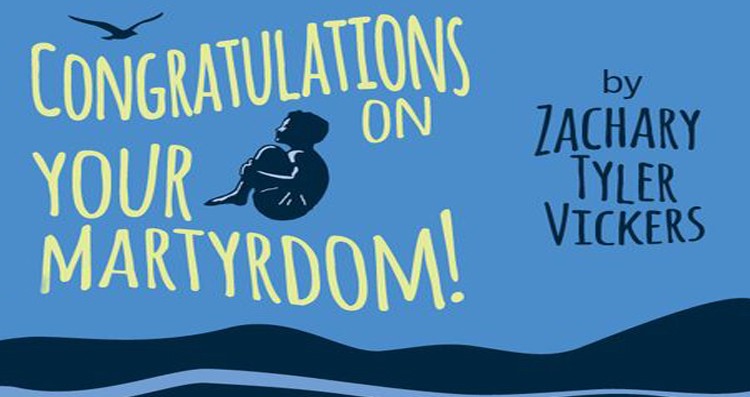Books & Culture
How to Be a Modern-Day Martyr
The loves and losses in Zachary Tyler Vickers’ Congratulations on Your Martyrdom!

Having read an extremely weird and wonderful story by Zachary Tyler Vickers’ that appeared in Hobart, and having interviewed him about said story, I thought I knew what to expect from his book, which came out at the end of May, 2016 from Indiana University Press. But Congratulations on Your Martyrdom! surprised me, in the same way that David Foster Wallace’s work surprised me when I first started reading it in earnest.
When encountering Wallace for the first time, it’s often through an excerpt or one of his cleverer short stories that are more digestible in undergrad writing courses. That is, the story or excerpt is likely good, even excellent, but it doesn’t convey the breadth and depth of what Wallace does in his work. Similar to encountering one story by George Saunders rather than reading a whole bunch of it, you may come away knowing that the author is very clever, intelligent, and has heart, but you won’t quite see the empathy that resonates within the lives of the often concept-driven story.
The stories in Congratulations on Your Martyrdom! are linked by space and time: they all take place in a small town that is struck by a tornado that has changed everyone and everything to some extent. Almost every story mentions another landmark occasion in the town — the time a boy jumped off the cliffs of the make-out area known, fittingly, as The Spot, and died. This is a small town that has a collective memory for such events, and the people who live there exist only in relation to one another. There is no story that includes a character who is entirely, 100% alone, because small town life simply doesn’t allow for it — and nor does Vickers (there is a story titled “Everything in Relation to Everything Else,” just to prove my point).
“Zachary Tyler Vickers’ work feels like a mix of Saunders and Wallace.”
Zachary Tyler Vickers’ work feels like a mix of Saunders (who blurbed the book and was a teacher at one point according to the acknowledgements) and Wallace (whom I know Vickers admires as we spoke about him at length) — but it is also entirely Vickers’ own. The qualities he shares with the Saunders and Wallace are a subtle and rather tragic humor, a sense of despairing hope or hopeful despair, and a fullness of empathy that is masked by intelligence so that one could skim the surface of these stories and enjoy them without seeing it if one were so disposed.
The language of the stories is impeccable, crisp and neat and tight, without superfluity, which is one of the ways skilled writers of a certain type allow, consciously or un-, the emotionality of their work to hide in plain sight. For example, take the first story, “Disfigured Paper Animals,” in which a Build-A-Bear-type shop begins using carcasses of real animals instead of the synthetic kind. The narrator of the story is the man who brings the stuffed animals to life with “Magical Foam Organs” and a stuffing hose dubbed the “Umbilical Cord” and sews them shut. He has overlarge hands, swollen and strange, and they haunt him.
Grammie described my hands as the manifestations of impure thoughts. But before the cobwebs, she mentioned it was genetic, gathering enough lucidity to recount Pop’s hands as fleshy oven mitts. He and Ma died in a plane crash. Pop was piloting. They were honeymooning. I was infantile. Grammie was babysitting. Sometimes I wonder if the plane crashed because of Pop’s inability to grip the controls.
The resonance of the sounds these sentences make — manifestations of impure thoughts; Pop was piloting — almost allow the reader to lose sight of the tragedy being described.
The stories aren’t in chronological order, but they share things that serve as clues to timeline, like the relation of each story to the tornado, to other characters, or to the kids who are always playing a game of Wiffle ball. In the single one where we get to experience the tornado, “Tornadic,” it serves only as an ending spot rather than as the point of the story. The point of the story also isn’t that the narrator’s ex-girlfriend keeps waking up with paper-cuts on her body in odd places and strange shapes, as haunting an image as that is. No, the point of the story, and of most of the others, is the loneliness of the narrator and how he deals with it.
Loneliness, in other words, is the martyrdom as I see it. The collection’s title is so brazen that it seems angry, as if telling off the characters in its own stories who aren’t doing enough to save themselves, to pull themselves up by whatever bootstraps they have and get to a happier place in life, whether that’s by pursuing a woman, getting over a death or five, or securing a better job. But these characters aren’t capable of what they wish they were capable of. Their martyrdom is in accepting their fates or in going against them but usually in a bit of a wrongheaded way.
“Vickers’ characters [are] deeply human, humane, yearning for love or satisfaction or recognition.”
In other words, they’re human. Vickers’ characters, like Saunders’ and Wallace’s, are — despite high concept moments, despite the humor inserted into their lives, despite the clever language their writer encases them in — deeply human, humane, yearning for love or satisfaction or recognition. They want to be seen. There’s a part of me that wants to reach into the pages of each story and stroke their faces while they sleep and tell them: you are seen. You are heard. But they live their lives unaware, which makes them so uniquely tragic.
In the penultimate story in the collection, “Tighter, Goodbye,” Vickers brings all these qualities together in a fantastic way:
The wreck during the ’92 snowstorm left Snapmare aphasic. Words jumble, linger at the tip of his randomly inarticulate tongue. Ma and Pa carpooled to heaven. Life insurance remedied little. Snapmare nine-to-fives at the KwikStop, clerking beside his freckled crush, Polly. He’s training to become the professional wrestling tag team partner of his buddy Nimrod. Wants Polly to be his redheaded ringside diva, hear her cheering him on from just outside the ropes. The scar on his head is an intimidating accessory, the difference between one heartbeat and the next. The difference being everything.
Snapmare, his sister Tiff, his buddy Nimrod, and his crush Polly are all tragic characters in this story, which ends in what is either elation or tragedy, depending on how you decide to read it. It hovers there, in between, leading to the next, and final, story, which deals with the woman beyond Tiff’s wall who listens to crying and game-shows and who is the grandmother of the dead boy who jumped from The Spot all those years ago.

The final stories in the collection own up to the theme of the whole — loneliness, connection, a desire to escape the former and reach the latter even if it’s by extreme measures of desperation — and as such make you want to start the whole thing over again and read the stories with eyes fresh with tears and a heart welling with the tight indescribable emotion that is the love for fictional characters who become so real you want to save them from themselves.









